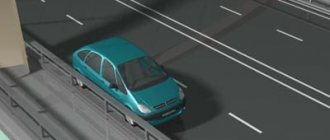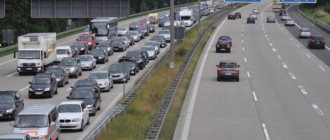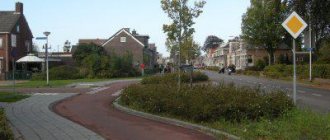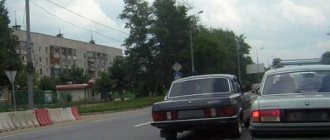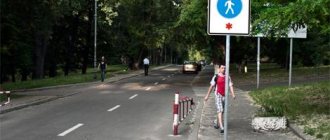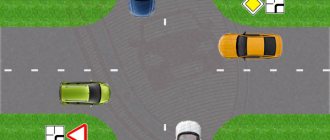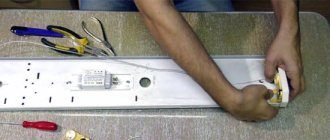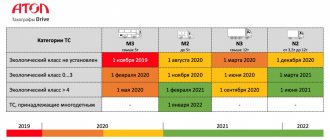roadway
Road Elements
The emphasis in this term is on trackless vehicles.
Tram tracks are not roadways.
- In special cases, the movement of trackless vehicles is allowed on tram tracks, but they are not intended for these purposes. Tram tracks are not located "on the" roadway, and "on the left of" - in cases where movement on them is allowed.
Rails to the left of the roadway"
Location
The number of lanes for traffic on the roadway is determined using the applied markings. In its absence, the driver must drive the vehicle, moving in his own lane and without interfering with other cars. The left side of the roadway on two-way roads is considered the oncoming side. Driving onto it is only permissible if you are overtaking.
On roads where there are two or more lanes for traffic in one direction, driving to the far left is allowed only if all other lanes are occupied. This usually happens when there is heavy traffic flow.
In addition, cars that are not capable of reaching high speeds should only move in the rightmost lane of the roadway. A different arrangement of vehicles is permissible when overtaking, changing lanes, or detouring.
Road lane
From the definitions of “road” and “roadway”, “traffic lane” is the third most nested element of the road.
The main element, the road, includes the roadway, and the roadway element is the traffic lane. Based on these terms, the existence of a traffic lane is impossible without a road. For a long time there was a dispute about the presence of roadways in courtyards and other adjacent areas.
This issue was closed by the decision of the Supreme Court of the Russian Federation in case No. AKPI12-205 dated April 17, 2012, with consideration of the contradictions of the Road Traffic Rules of the Russian Federation and the Convention on Road Traffic. In particular, this decision contains that elements of the road network can be located in adjacent areas.
in adjacent territories there may be elements of the road network (roadway, sidewalk, etc.), the totality of which constitutes a road according to the definition of the term “road” in paragraph 1.2 of the Rules
On the one hand, this goes beyond the strict framework of the elements described in the text, on the other hand, it falls within the logical framework. The adjacent territories are also intended for traffic, road accidents occur there and traffic is regulated by the same rules. Regulatory documents on road construction come into conflict, and then the means of organizing traffic. Sometimes it is impossible to visually distinguish a road and the surrounding area without finding out who owns a specific piece of land. In adjacent territories, roads are not built as linear construction projects, but individual elements can form a road in the context of the Road Traffic Regulations. Other departments that deal with traffic on the road network are responsible for organizing traffic in the adjacent territory.
Returning to traffic lanes, it is also often impossible to mark them according to regulatory documents (for example, ensure a width of 3 meters, mark them with appropriate intersection signs, and so on. But again, in the context of traffic rules terms, there are traffic lanes in the adjacent territories.
Road
The central concept of traffic rules is the road. How else could it be in the ROAD Rules?
Definition from traffic rules (clause 1.2):
“Road” is a strip of land or a surface of an artificial structure equipped or adapted and used for the movement of vehicles. The road includes one or more carriageways, as well as tram tracks, sidewalks, shoulders and dividing strips, if any.
Suitability for traffic is one of the main criteria of a road. An embankment, a dam, an asphalted, concreted, paved section of the earth's land, etc., along which vehicles (hereinafter referred to as vehicles) move, is a road.
But artificial structures (overpasses, overpasses, bridges) that are used to move vehicles are also roads.
Two narrow strips of trampled grass extending into a field? And this is the road.
And even if in the bitter winter a local tractor driver lays a “winter road” right across the field with the help of his bulldozer (to make it shorter to travel to meet his beloved), then this will also be a road. It may be temporary (until the spring thaw), but it’s a journey!
What about the ice crossing? There is no such concept in the traffic rules, but there is a definition that this is also a road. No wonder it is indicated by road signs.
And even brushwood or logs thrown into a swampy peat bog turn into a road - a road in the swamp.
And on all these numerous road options, the Traffic Rules apply (or, as they say, “work”).
So, a road is a section prepared and intended for vehicle traffic
.
It includes (as can be seen from the second part of the quote) the following main elements:
- roadway (one or more), which is divided into traffic lanes;
- dividing strip (if available);
- curbs (if available);
- sidewalks (if available);
- tram tracks (if available).
Let's talk about these elements of the road.
roadway
Very often there is confusion with the concepts of “roadway” and “road”. By road we often mean the very asphalt on which vehicles move.
This is mistake! That same asphalt is only part of the road. Namely, the carriageway.
Definition from traffic rules (clause 1.2):
“Carriageway” is an element of the road intended for the movement of trackless vehicles.
And it turns out that it is not the road that has the asphalt surface, but its carriageway.
And it is not asphalt that is the criterion for the roadway, but the movement of trackless vehicles. The roadway can be decorated with a different coating - rubble stone, paving stones, crushed stone - or simply have a soil base.
But this is a roadway that was created specifically for the movement of trackless vehicles. The tram is not one of them.
Lane
Exclusively for the convenience of traffic, the roadway is divided by longitudinal marking lines into special sections - traffic lanes (or traffic lanes).
Definition from traffic rules (clause 1.2):
“Traffic lane”
is any of the longitudinal stripes of the roadway, marked or not marked with markings and having a width sufficient for the movement of cars in one row.
In order not to “get lost” on a wide roadway, the driver needs some kind of landmark when driving. Such a landmark is a traffic lane, the width of which is sufficient for unhindered and safe movement.
But what to do in winter, when the markings are indistinguishable?
Or is it not applied to the roadway at all?
In this case, the driver is obliged to independently determine his position on the roadway. And this is done like this: the roadway is divided by a longitudinal line strictly in the middle; the area on the right is ours, on the left is the “oncoming” one.
And the final touch is how many vehicles can pass each other at the same time in one section of the road. The number of vehicles capable of doing this will indicate the number of lanes.
Consequently, lanes for vehicle traffic are necessarily present on the roadway. The driver just needs to find them.
Dividing strip
There are sections of roads in the middle of which you can find an original design - a dividing strip.
Definition from traffic rules (clause 1.2):
“Dividing strip”
is a road element, designated structurally and (or) using markings 1.2.1, separating adjacent roadways and not intended for the movement and stopping of vehicles.
Judging by the definition, a dividing strip is a “dead” section of the road, which is strictly prohibited for movement, stopping and parking of vehicles.
Why is there a dividing line? To ensure traffic safety! A dividing strip demarcates and separates traffic flows in opposite directions, making it difficult (or impossible) to enter oncoming lanes. That is why the highway (the fastest section of the road!) must necessarily have a dividing strip (or fences in the middle of the road).
However, the dividing strip can be designed not only with the help of some kind of physical structure, but also with the help of “single continuous” markings (1.2.1).
It is also forbidden to drive, stop or park on such a section of the road.
Speaking about the dividing strip, one cannot fail to note its another important property: the dividing strip distinguishes adjacent roadways
.
And one last point. It is clear that the median strip is not a mandatory element of the road, but has a positive effect on safety.
Roadside
As strange as it may seem, the shoulder is also an element (or part) of the road. And all because traffic on the side of the road is, in rare cases, permitted by the Rules. And most importantly, the shoulder is a section of the road where stopping and parking of vehicles is allowed.
Definition from traffic rules (clause 1.2):
“Shoulder”
is an element of the road adjacent directly to the roadway at the same level with it, differing in the type of surface or marked out using markings 1.2.1 or 1.2.2, used for driving, stopping and parking in accordance with the Rules.
A shoulder is a road element that is directly adjacent to the roadway and, moreover, in the same plane. Therefore, it cannot be separated from the roadway by some kind of lawn or curb. It is precisely “glued” to the roadway, because it is intended mainly for stopping and parking.
As a rule, the shoulder differs from the asphalt roadway in a different way of covering: it can be expressed as grass, crushed stone, soil, sand, clay, etc.).
However, on large federal highways it is practiced to form the shoulder using the same coating as on the roadway. This is done to ensure maximum safety on the highway so that particles of soil, sand, and clay do not fall onto the roadway and cause trouble during emergency braking of the vehicle.
In this case, the border between the roadway and the shoulder will be a special - continuous or broken - marking line.
Speaking about the side of the road, it should be noted that it is not a mandatory road element. As a rule, in populated areas there is no shoulder as it is unnecessary, because vehicles park or stop using the edge of the roadway.
Consequently, the side of the road is the lot of country roads. By the way, here - in the absence of sidewalks - pedestrian traffic is also allowed.
Sidewalk
A sidewalk is another road element. It is quite justified to classify it as one of the parts of the road. And that's why.
Definition from traffic rules (clause 1.2):
“Sidewalk” is an element of the road intended for pedestrian traffic and adjacent to the roadway or bicycle path or separated from them by a lawn.
In principle, everything is simple and clear. The sidewalk is for pedestrians, and they are traffic participants. That’s why the sidewalk is part of the road. However, in the rarest cases, vehicles are allowed to move along it, as well as stop and park them.
Sidewalks, like curbs, are not a necessary element of the road.
Outside the populated area there is practically no need for them: pedestrians move along the roadsides.
Tram rails
There are many inaccuracies, “blank spots”, etc. in our traffic regulations. One of the gaps is the lack of definition of tram tracks, which are part of the road, but are not a carriageway. Such characteristics are determined by the analysis of the concepts of “road” and “roadway”.
There are two preferential ways to organize tram routes (within the road):
1) in the middle of the road;
2) on the border with the roadway.
The inattention of traffic regulations to the concept of “tram tracks” is unjustified, because they can be used for traffic (in accordance with traffic regulations).
Obviously, we are invited to think for ourselves: tram tracks are a section of road intended for the movement of rail vehicles
.
Marked or unmarked
From the paragraph above, according to regulatory documents, it is possible to designate only lanes on correspondingly “regulatory” roads. Means of organizing traffic in adjacent areas can also be used, but depending on the situations, their requirements may differ. For example, you can often see the 5.5 sign at gas stations and parking lots. “One-way traffic”, but since there is no “standard” road, it will not be possible to move along one-way traffic in violation. In the same parking lot, on the opposite side, there is a “Brick” hanging - it is no longer tied to the road, and a lawful fine will be issued for violating this sign. You can often find narrow lane markings in parking lots, and no one will issue a fine for violating such markings or driving into oncoming traffic for crossing a solid line. Mandatory and priority signs must be followed. And so on, there are many cases.
Longitudinal strip
And even in the “longitude” of the strip, disputes arise. There is a longitudinal stripe in the profile of a “normative” road, and there is a longitudinal stripe in the direction of the road.
Longitudinal strip
Here you should look in reverse and imagine a non-longitudinal strip - the option suitable for traffic rules will become obvious.
Profile of a roadway with a longitudinal stripe
Longitudinal strip of the roadway
It quite fits the definition; the strip runs along the surface of the roadway. This looks ridiculous until the physical width of the road changes. When the road narrows, someone allows the traffic lane to be positioned across the roadway.
Road narrows
Special markup
The lanes of the roadway are always separated by special markings. In this case, it is easier for the driver to navigate in his direction of travel. But what should the latter do if it’s winter outside or there are simply no markings? You will have to determine the lane yourself. To do this, the driver needs to mentally divide the roadway in half and select the right lane. Its left direction will be counter. Those. designed for traffic from the opposite side.
Lane width
“Having a width sufficient to allow vehicles to move in one row.”
Here the dispute arises from a certain conclusion about the prohibition of two cars in one lane. This conclusion has no basis. The term defines a traffic lane. And if the width is sufficient for the movement of cars in one radius, it is a traffic lane; if it is not enough, it is not a traffic lane. Under different conditions, the number of stripes may change while maintaining the same width. The basis for choosing the number of lanes is maintaining a safe interval between vehicles.
An example of increasing the number of stripes while maintaining the original width in the probok.net project:
Adding a lane by narrowing other lanes
traffic rules road
A road is a strip of land (a system of structures) developed and used for the movement of vehicles.
The road may consist of the following elements:
- a roadway consisting of traffic lanes;
- tram rails;
- roadsides;
- sidewalks;
- dividing strips.
The carriageway is an element of the road along which the movement of trackless vehicles occurs. A road may consist of one or more carriageways, which are separated from each other by dividing strips. If the road has a dividing strip, then it consists of several carriageways. If oncoming traffic is separated by a solid double line (marking 1.3), then the road consists of one carriageway.
Road Divider
An element of the road, distinguished either structurally and/or using markings 1.2.1, which marks the edge of the roadway. The median strip separates adjacent roadways and is not intended for the movement and stopping of vehicles.
At the same time, rails are sometimes laid on the dividing strip for the movement of trams. Again, we need to pay attention to the following important point. If tram lines are located on a dividing strip (a structurally designated section of the road), then, of course, trackless vehicles are prohibited from moving along them. But, if tram lines are laid in the middle of the road at the same level as the roadway, then vehicle traffic on them can be allowed.
Road lane
Any of the longitudinal stripes of the roadway, marked (not marked) with appropriate markings.
Any of the longitudinal stripes of the roadway, marked (not marked) with appropriate markings. If the traffic lane is not marked with markings, then its width is assumed to be sufficient for vehicles to move in one row.
For this reason, motorcycles can move in several rows on one lane, and this will not be considered a traffic violation if motorcyclists maintain a safe distance between themselves and other road users.
Sidewalk and roadside
A sidewalk element of a road that is intended for pedestrian traffic and is adjacent to the roadway, bicycle path, or separated from them by a lawn. Typically, sidewalks are raised above the roadway and separated from them by curbstones.
A roadside element that adjoins directly to the roadway at the same level as it. In this case, the side of the road differs from the roadway in the type of coating, or is distinguished using markings 1.2.1 or 1.2.2.
